
|
|
25 November, 2003
In early January 1911, Robert Falcon Scott and his men arrived at
Cape Evans aboard the ship the Terra Nova. They brought with them 33
dogs, 19 ponies, 3 motor tractors, and a prefabricated wooden
building to serve as base for their expedition to the South Pole. The
1000 square foot hut was completed by the middle of the month, and
Scott and his men moved in. That hut still stands at Cape Evans and
has been restored through the efforts of the Antarctic Heritage
Trust, a New Zealand-based organization. While anyone can view the
hut from outside, if you want to get inside you must obtain a key
from the National Science Foundation office in McMurdo. Since we
are only 10 minutes from Cape Evans by snowmobile, this was a great
night to get the key and visit the hut.
As Scott said, when he described the hut in his journal, "The word
'hut' is misleading, our residence is really a house of considerable
size, in every respect the finest that has been erected in polar
regions." 25 men lived in the hut, which also had an attached stables
area to shelter the 19 ponies and 33 dogs that accompanied the
expedition. It was a tightly constructed building, insulated from
the cold with layers of dried seaweed sewn into jute quilting
covering the floor, walls, and roof. In addition, the roof was
waterproofed with 'Ruberoid'-felt that had been treated with tar.
The floor was covered with linoleum that is still visible today. For
heat, they used two coal-burning stoves-one in the kitchen area and a
smaller one in the sleeping quarters. During the summer months, the
hut got its light through three double-paned windows, while in winter
darkness they used two acetylene generators to keep twelve lights
burning. The stables were built off one side of the hut using wood
salvaged from their ship, with outside walls formed from blocks of
coal and bales of pony fodder. At one end of the stables there was a
stove that was fueled by seal blubber. Besides providing heat, it
was used to melt snow for water and mix warm food for the livestock.
While Scott's primary objective was to be the first to reach the
South Pole, his mission was also scientific. Members of his party
included a meteorologist and physicist, as well as biologists. The
hut had a well equipped darkroom as well as an area reserved for
science with beakers, chemicals, and assorted lab equipment. There
was a weather station near the hut that was used to obtain daily
meteorological reports.
Two years after the survivors of Scott's expedition had returned
home, this hut became home for members of Shackleton's Ross Sea
Party. You can still see the anchor that remained after their ship,
The Aurora, had blown out to sea. Luckily, Scott's group had left a
year's worth of supplies at the hut when they left. Members of the
crew used old tents and caribou skin sleeping bags to sew pants,
jackets, and boots. They killed seals for food and used the blubber
to heat the hut and as fuel for cooking. They collected eggs from a
nearby Adelie Penguin rookery to supplement their 'mostly seal' diet.
After their rescue in 1917 the hut sat abandoned until its
restoration almost 50 years later.
Restoration began in the summer of 1960-61. Most of the hut was
filled with ice and shelves in the kitchen area had collapsed under
the weight of the past years' accumulated snows. The ice was cleared
the hard way-with a pick and shovel. When artifacts were found, they
were left encased in their icy jackets and placed outside to thaw.
Excavation and restoration continued throughout the 1970s. In the
late 1980s the building's roof was snow-proofed by the addition of a
new waterproof layer of rubber covered with plywood.
The interior of the hut looks almost as if its inhabitants had just
left. There are reindeer hide sleeping bags on some of the bunks,
with canvas pants hanging on nearby hooks. Gloves and mitts hang on
the walls and reindeer fur boots called finnesko, with their felt
liners, are ready to go. The kitchen is well stocked with cans and
jars. There are even a few bottles of Heinz Ketchup on the shelves
that must have been meant to complement the tins of meat the
expedition brought with them. The lab area has a table covered with
glassware and assorted bottles of chemicals, and the darkroom still
has photographic plates awaiting exposure and developing. In the
stables area a pile of seal blubber lies waiting next to the stove,
while a box of penguin eggs collected by Shackleton's men sits
nearby. There are even bales of sennet grass, used to line and
insulate the finnesko, sitting in one of the stables.
What was it really like for those men to live on the shore of the
Ross Sea? It's hard to imagine the level of determination that kept
them going forward with their plans. To really get a feel for both
these expeditions, I recommend reading some of the first-hand
accounts that are available. To learn more about Scott's expedition,
you should read The Worst Journey in the World by Appsley
Cherry-Garard. If you want a really gripping story, try Shackleton's
Forgotten Men. This book is about the men of the Ross Sea Party who
were stranded at Cape Evans while Shackleton and his men of the
Endurance were stuck in the ice of the Weddell Sea on the opposite
coast of Antarctica.
Daily Haiku:
Standing in Scott's hut
Trying to hear the stories
Left by artifacts

The hut at Cape Evans.
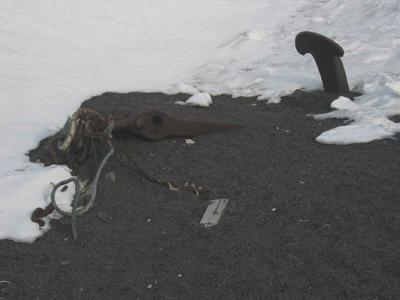
This is all that remains of the ship The Aurora. It tore free from its anchor during a storm, leaving most of the crew onshore.
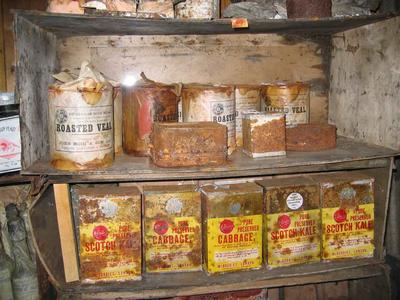
Food tins left in the hut's kitchen.
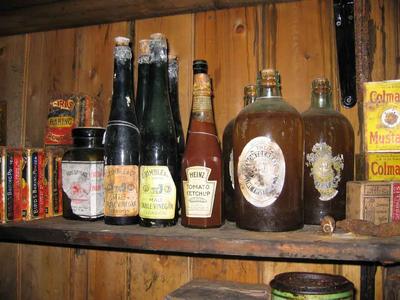
I think that Scott's group had more ketchup than we have!

This is a recreation of Scott's bunk, with sleeping robe, blankets, pillows, gloves,and boots.
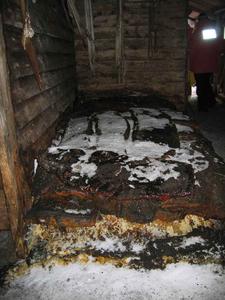
Piles of seal blubber ready to put in the stove.

These are some of the penguin eggs collected by Shackleton's men.
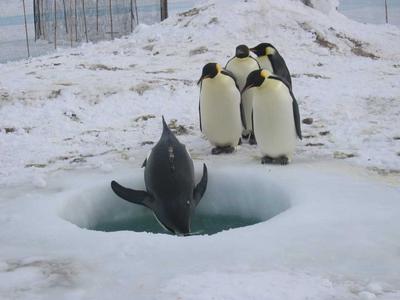
A group of Emperor Penguins ready to go swimming.
Contact the TEA in the field at
.
If you cannot connect through your browser, copy the
TEA's e-mail address in the "To:" line of
your favorite e-mail package.
|
